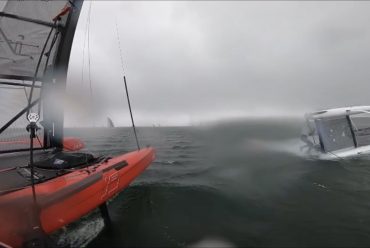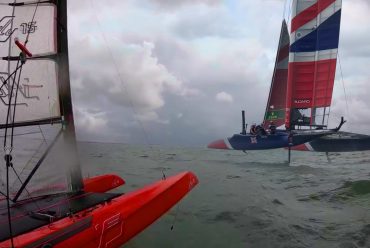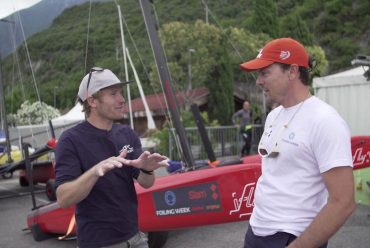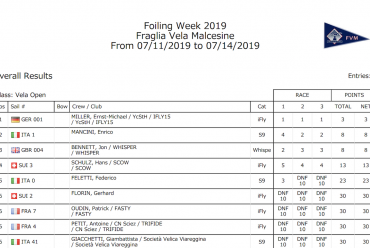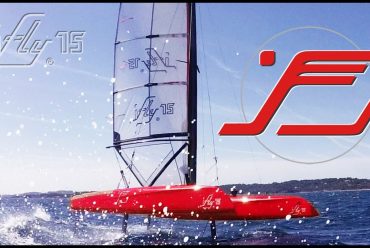Performance Sailing – Actualités Sail GP: Racing on the Edge – Le T-Foil s’avère être le design gagnant
Comparaison : Configurations de Foil – Parfois, cela prend un certain temps…
FROM JIMMY SPITHILL’S EXIT TO SAILGP’S IN-DEVELOPMENT T-FOILS
REVEALED: SailGP’s in-development T-Foils produce ‘unexpected’ performance gains in first testing phase
https://sailgp.com/news/23/revealed-tfoils-f50-performance-gains-first-testing-phase/
https://sailgp.com/news/23/november-top-stories-spithill-exit-tfoil-testing/
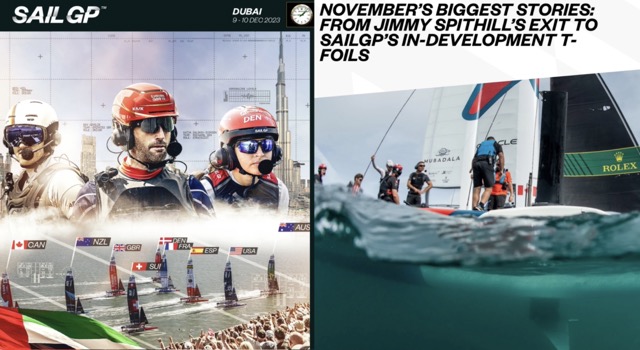
Parfois, il faut un certain temps avant que les gens comprennent… Le cerveau derrière iFLY, Gilbert Saint-Blancat, a écrit un résumé scientifique sur la supériorité de la configuration du foil en T – pour le magazine français CourseAuLarge – en décembre 2013, 10 ans avant que SailGP n’annonce maintenant qu’ils changent la conception du F50 en configuration T-foil. J’ai eu des centaines de discussions sur ce sujet… tellement de gens m’ont dit que les T-Foils étaient lents, même si l’iFLY RAZZOR atteignait 31 nœuds. et 20 nœuds. au près, et le papillon est sans aucun doute des foilers super rapides. Les safrans de classe A sont revenus aux T-Foils, l’America’s Cup est déjà là, les TF35 foils sont impressionnants même dans les conditions de vent les plus faibles, et l’AC40 (sur T-foils) vole actuellement à Djeddah à des vitesses de vent incroyablement faibles avec 3-4. fois la vitesse du vent. Vive le T-Foil ! C’est la solution logique, pour séparer les 2 tâches, sustentation et anti-dérive. Ils autorisent des profils plus étroits avec une portance équivalente. Il est donc moins sensible à la cavitation et possède une vitesse limite plus élevée.
10 years later:
NOVEMBER 23, 2023, SailGP announce that they are – finally – changing their foil configuration to T-Foils
![]()
![]()
![]()
![]()
![]()
![]()
French magazine CourseAuLarge – December 2013
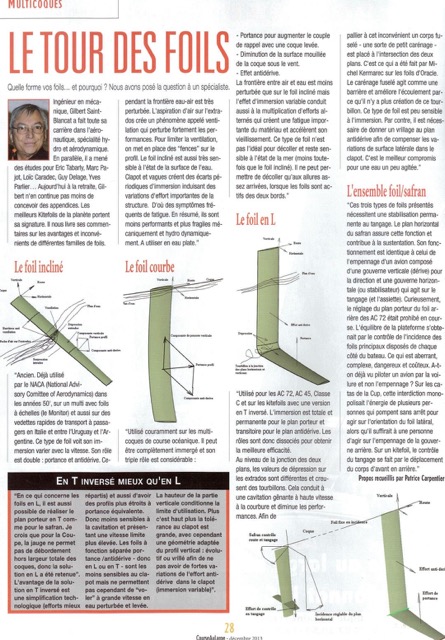
French original essay:
LE TOUR DES FOILS
Quelle forme pour vos foils… et pourquoi ? Nous avons posé la question à un spécialiste.
Ingénieur en mécanique, Gilbert Saint-Blancat a fait toute sa carrière dans l’aéronautique, spécialité hydrodynamique et aérodynamique.
En parallèle, il a mené des études pour Eric Tabarly, Marc Pajot, Loïc Caradec, Guy Delage, Yves Parlier… Aujourd’hui à la retraite, Gilbert n’en continue pas moins de concevoir des appendices. Les meilleurs Kitefoils de la planète portent sa signature. Il nous livre ses commentaires sur les avantages et inconvénients de différentes familles de foils.
Le foil incliné :
« Ancien. Déjà utilisé par le NACA (National Advisory Comittee of Aerodynamics) dans les années 1950, sur un multi avec foils à échelles (le Monitor) et aussi sur des vedettes rapides de transport à passagers en Italie et entre l’Uruguay et l’Argentine. Ce type de foil voit son immersion varier avec la vitesse. Son rôle est double : portance et antidérive. Cependant, la frontière eau-air est très perturbée. L’aspiration d’air sur l’extrados crée un phénomène appelé ventilation qui perturbe fortement les performances. Pour limiter la ventilation, on met en place des « fences » sur le profil. Le foil incliné est aussi très sensible à l’état de la surface de l’eau.
Clapot et vagues créent des écarts périodiques d’immersion induisant des variations d’effort importantes de la structure. D’où des symptômes fréquents de fatigue. En résumé, ils sont moins performants et plus fragiles mécaniquement et hydro dynamique-ment. A utiliser en eau plate. »
Le foil courbe:
« Utilisé couramment sur les multicoques de course océanique. Il peut être complètement immergé et son triple rôle est considérable :
• Portance pour augmenter le couple de rappel avec une coque levée.
• Diminution de la surface mouillée de la coque sous le vent.
• Effet antidérive.
La frontière entre air et eau est moins perturbée que sur le foil incliné mais l’effet d’immersion variable conduit aussi à la multiplication d’efforts alternés qui créent une fatigue importante du matériau et accélèrent son vieillissement. Ce type de foil n’est pas l’idéal pour décoller et reste sensible à l’état de la mer (moins toutefois que le foil incliné). Il ne peut permettre de décoller qu’aux allures assez arrivées, lorsque les foils sont actifs des deux bords. »
Le foil en L:
« Utilisé pour les AC 72, AC 45, Classe C et sur les kitefoils avec une version en T inversé. L’immersion est totale et permanente pour le plan porteur et transitoire pour le plan antidérive. Les rôles sont donc dissociés pour obtenir la meilleure efficacité.
Au niveau de la jonction des deux plans, les valeurs de dépression sur les extrados sont différentes et creusent des tourbillons. Cela conduit à une cavitation gênante à haute vitesse à la courbure et diminue les performances.
Afin de pallier à cet inconvénient un corps fuselé – une sorte de petit carénage – est placé à l’intersection des deux plans. C’est ce qui a été fait par Michel Kermarec sur les foils d’Oracle.
Le carénage fuselé agit comme une barrière et améliore l’écoulement parce qu’il n’y a plus création de ce tour-billon. Ce type de foil est peu sensible à l’immersion. Par contre, il est nécessaire de donner un vrillage au plan antidérive afin de compenser les variations de surface latérale dans le clapot. C’est le meilleur compromis pour une eau un peu agitée. »
L’ensemble foil/safran:
« Ces trois types de foils présentés nécessitent une stabilisation permanente au tangage. Le plan horizontal du safran assure cette fonction et contribue à la sustentation. Son fonctionnement est identique à celui de l’empennage d’un avion composé d’une gouverne verticale (dérive) pour la direction et une gouverne horizontale (ou stabilisateur) qui agit sur le tangage (et l’assiette). Curieusement, le réglage du plan porteur du foil arrière des AC 72 (34th AC – 2013), était prohibé en course. L’équilibre de la plateforme s’obtenait par le contrôle de l’incidence des foils principaux disposés de chaque côté du bateau. Ce qui est aberrant, complexe, dangereux et coûteux. A-t-on déjà vu piloter un avion par la voilure et non l’empennage ? Sur les catas de la Cup, cette interdiction monopolisait l’énergie de plusieurs personnes qui pompent sans arrêt pour agir sur l’orientation du foil latéral, alors qu’il suffirait à une personne d’agir sur l’empennage de la gouverne arrière. Sur un kitefoil, le contrôle du tangage se fait par le déplacement du corps d’avant en arrière. »
EN T INVERSÉ MIEUX QU’EN L:
« En ce qui concerne les foils en L, il est aussi possible de réaliser le plan porteur en T comme pour le safran. Je crois que pour la Coupe (34th AC – 2013), la jauge ne permet pas de débordement hors largeur totale des coques, donc la solution en L a été retenue ».
L’avantage de la solution en T inversé est une simplification technologique (efforts mieux répartis) et aussi d’avoir des profils plus étroits à portance équivalente. Donc moins sensibles à la cavitation et présentant une vitesse limite plus élevée. Les foils à fonction séparée portance /antidérive – donc en L ou en T – sont les moins sensibles au cla-pot mais ne permettent pas cependant de « voler » à grande vitesse en eau perturbée et levée. La hauteur de la partie verticale conditionne la limite d’utilisation. Plus c’est haut plus la tole-rance au clapot est grande, avec cependant une géométrie adaptée du profil vertical : évolutif ou vrillé afin de ne pas avoir de fortes variations de l’effort anti-dérive dans le clapot (immersion variable) ».
French CourseAuLarge magazine – décembre 2013
Propos recueillis par Patrice Carpentier
10 annés plus tard:
23 NOVEMBER 2023, SailGP annoncent qu’ils changent – enfin – leur configuration de foil en foils en T
https://sailgp.com/news/23/november-top-stories-spithill-exit-tfoil-testing/
Read the full essay from Gilbert Saint-Blancat in its English translation:
THE FOIL TOUR
What shape for your foils… and why? We asked an expert.
As a mechanical engineer, Gilbert Saint-Blancat has spent his entire career in aeronautics, specializing in hydrodynamics and aerodynamics.
At the same time, he carried out studies for Eric Tabarly, Marc Pajot, Loïc Caradec, Guy Delage, Yves Parlier … Now retired, Gilbert nonetheless continues to design foils. The best Kitefoils on the planet bear his signature. He gives us his comments on the advantages and disadvantages of different families of foils.
The inclined foil:
« Outdated. Already used by the NACA (National Advisory Committee of Aerodynamics) in the 1950s, on a multi with ladder foils (the Monitor) and also on speedboats for passenger transport in Italy and between Uruguay and Argentina. This type of foil sees its immersion vary with speed. Its role is twofold: lift and anti-drift. However, the water-air boundary is very disrupted. The suction of air on the upper surface creates a phenomenon called ventilation which greatly disrupts performance. To limit ventilation, “fences » are put in place on the profile. The inclined foil is also very sensitive to the state of the water surface. Chop and waves create periodic variations in immersion inducing significant variations in the stress of the structure. Hence frequent symptoms of fatigue. In summary, they are less efficient and more fragile mechanically and hydrodynamically. To be used in still water. »
The curved foil:
« Commonly used on ocean racing multihulls. It can be completely submerged and its triple role is considerable:
• Lift to increase the restoring torque with a raised hull.
• Reduction in the wetted surface area of the leeward hull.
• Anti-drift effect.
The boundary between air and water is less disturbed than on the inclined foil but the variable immersion effect also leads to the multiplication of alternating forces which create significant fatigue of the material and accelerate its aging. This type of foil is not ideal for taking off and remains sensitive to the state of the sea (less, however, than the inclined foil). It can only take off at relatively high speeds when the foils are active on both sides. »
The L-shaped foil:
« Used for the AC72, AC45, C-Class, and on kite foils with an inverted T version. Immersion is total and permanent for the supporting plane and transient for the anti-drift plane. The roles are therefore separated to obtain the best efficiency.
At the junction of the two planes, the depression values on the extrados are different and create vortices. This leads to annoying cavitation at high speeds at the bend and decreases performance.
In order to overcome this drawback, a tapered body – a sort of small fairing – is placed at the intersection of the two planes. This is what was done by Michel Kermarec on the Oracle foils. The tapered shroud acts as a barrier and improves flow because there is no more creation of this swirl. This type of foil is not very sensitive to immersion. On the other hand, it is necessary to twist the anti-drift plane in order to compensate for the variations in lateral surface in the chop. It’s the best compromise for slightly choppy water. »
The foil/rudder assembly:
« These three types of foils presented require permanent pitch stabilization. The horizontal plane of the rudder ensures this function and contributes to lift. Its operation is identical to that of the tail of an aircraft composed of a vertical rudder (fin) for the steering and a horizontal rudder (or stabilizer) which acts on the pitch (and the flight attitude). Curiously, the adjustment of the supporting plane of the rear foil of the AC72 was prohibited in racing. The balance of the platform is obtained by controlling the incidence of the main foils placed on each side of the boat. Which is aberrant, complex, dangerous, and costly. Have we ever seen a plane piloted by the wing and not the tail? On the (34th – 2013) America’s Cup catamarans, this ban monopolized the energy of several people who pump constantly to act on the orientation of the lateral foil, whereas it would be enough for one person to act on the tail of the rear rudder. On a kite foil, pitch control is done by simply moving the body back and forth. »
The REVERSED T: BETTER THAN the L configuration:
« As for the L-shaped foils, it is also possible to make the T-shaped supporting plane as for the rudder. I believe that for the (34th – 2013) America’s Cup, the gauge does not allow overflow outside the total width of the hulls, therefore the solution in L was retained.”
The advantage of the inverted T solution is a technological simplification (efforts better distributed) and also having narrower profiles with equivalent lift. Therefore, it is less sensitive to cavitation and has a higher limiting speed. Foils with a separate lift/anti-drift function – therefore L or T – are the least sensitive to splashing but do not, however, allow you to « fly » at high speed in disturbed and lifted water. The height of the vertical part determines the limit of use. The higher it is, the greater the tolerance in chop, however with an adapted geometry of the vertical profile: scalable or twisted so as not to have strong variations in the anti-drift effort in chop (variable immersion) »
French magazine CourseAuLarge – December 2013
https://sailgp.com/news/23/revealed-tfoils-f50-performance-gains-first-testing-phase/
https://sailgp.com/news/23/november-top-stories-spithill-exit-tfoil-testing/
Here iFLY Razzor Pro Video from 2021 – Stay tuned for the new video from 2023

